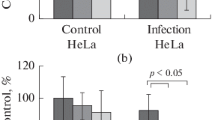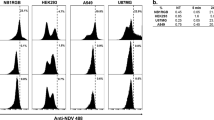Abstract
Newcastle disease virus (NDV) is a member of genus Avulavirus within the family Paramyxoviridae. Interest of using NDV as an anticancer agent has arisen from its ability to kill tumor cells with limited toxicity to normal cells. In this investigation, the cytotolytic properties of NDV strain AF2240 were evaluated on brain tumor cell line, anaplastic astrocytoma (U-87MG), by using MTT assay. Cytological observations were studied using fluorescence microscopy and transmission electron microscopy to show the apoptogenic features of NDV on U-87MG. DNA laddering in agarose gel electrophoresis and terminal deoxyribonucleotide transferase-mediated dUTP-X nick end-labeling staining assay confirmed that the mode of cell death was by apoptosis. However, analysis of the cellular DNA content by flowcytometery showed that there was a loss of treated U-87MG cells in all cell cycle phases (G1, S and G2/M) accompanied with increasing in sub-G1 region (apoptosis peak). Early apoptosis was observed 6 h post-inoculation by annexin-V flow-cytometry method. It could be concluded that NDV strain AF2240 is a potent antitumor agent that induce apoptosis and its cytotoxicity increasing while increasing of time and virus titer.











Similar content being viewed by others
References
Alabsi A (2008) Effects of newcastle disease virus strains AF2240 and V4-UPM on cytolysis and apoptosis of leukemia cell lines. Doctor of philosophy Thesis, Universiti Putra Malaysia, Malaysia
Alexander DJ (1988) Newcastle disease diagnosis. In: Alexander DJ (ed) Newcastle disease. Kluwer Acadimic Publishers, Netherlands, pp 147–160
Aubry J, Blaecke A, Lecoanet-Henchoz S, Jeannin P, Herbault N, Caron G, Moine V, Bonnefoy J (1999) Annexin V used for measuring apoptosis in the early events of cellular cytotoxicity. Cytometry 37:197–204
Chambers P, Samson ACR (1980) A new structural protein for Newcastle disease virus. J Gen Virol 50:155–166
Chan KM, Rajab NF, Ishak MHA, Ali AM, Yusoff K, Din LB, Inayat-Hussain SH (2006) Goniothalamin induces apoptosis in vascular smooth muscle cells. Chemico-Biol Interact 159:129–140
Clarke RG, Lund EK, Johnson IT, Pinder AC (2000) Apoptosis can be detected in attached colonic adenocarcinoma HT29 cells using Annexin V binding, but not by TUNEL assay or sub-G0 DNA content. Cytometry 39:141–150
Cohen GM, Sun XM, Snowden RT, Dinsdale D, Skilleter DN (1992) Key morphological features of apoptosis may occur in the absence of internucleosomal DNA fragmentation. Biochem J 286:331–334
Doonan F, Cotter TG (2008) Morphological assessment of apoptosis. Methods 44:200–204
Doyle TM (1927) A hitherto unrecorded disease of fowls due to a filter passing virus. J Comp Pathol 40:144–169
Engeland MV, Nieland LJW, Ramaekers FCS, Schutte B, Reutelingsperger CPM (1998) Annexin V-Affinity assay: a review on an apoptosis detection system based on phosphatidylserine exposure. Cytom 31:1–9
Fenner F, Bachmann P, Gibbs E, Murphy F, Studdert M, White D (1987) Veterinary Virol. Academic Press, Orlando
Freeman AI, Zakay-Rones Z, Gomori JM, Linetsky E, Rasooly L, Greenbaum E, Rozenman-Yair S, Panet A, Libson E, Irving CS, Galun E, Siegal T (2006) Phase I/II trial of intravenous NDV-HUJ oncolytic virus in recurrent glioblastoma multiforme. Mol Ther 13:221–228
Fried J, Perez AG, Clarkson BD (1976) Flow cytofluorometric analysis of cell cycle distributions using propidium iodide, Properties of the method and mathematical analysis of the data. J Cell Biol 71:172–181
Gao N, Keane MJ, Ong T, Ye J, Miller WE, Wallace WE (2001) Effects of phospholipid surfactant on apoptosis induction by respirable quartz and kaolin in NR8383 rat pulmonary. Toxicol Appl Pharmacol 175:217–225
Gavrieli Y, Sherman Y, Ben-Sasson SA (1992) Identification of programmed cell death in situ via specific labeling of nuclear DNA fragmentation. J Cell Biol 119:493–501
Gooch JL, Yee D (1999) Strain-specific differences in formation of apoptotic DNA ladders in MCF-7 breast cancer cells. Cancer Lett 144:31–37
Guan T, Qin F, Du J, Geng L, Zhang Y, Li M (2007) AICAR inhibits proliferation and induced S-phase arrest, and promotes apoptosis in CaSki cells. Acta Pharmacologica Sinica 28:1984–1990
Henson JW (2005) Glioblastoma multiforme and anaplastic glioma: a patient guide. http://brain.mgh.harvard.edu/PatientGuide.htm. Accessed on 7 Feb
Kirn D, Martuza RL, Zwiebel J (2001) Replication-selective virotherapy for cancer: biological principles, risk management and future directions. Nat Med 7:781–787
Lin JC, Ho YS, Lee JJ, Liu CL, Yang TL, Wu CH (2007) Induction of apoptosis and cell-cycle arrest in human colon cancer cells by meclizine. Food Chem Toxicol 45:935–944
Lin W, Li D, Chen Q, Lu H (2004) Clinical and experimental study of oxaliplatin in treating human gastric carcinoma. World J Gastroenterol 19:2911–2915
Liu C, Xu HY, Liu (2001) Induction of caspase-dependent apoptosis in cultured cells by the avian coronavirus infectious bronchitis virus. Am Soc Microbiol 75:6402–6409
Lorence RM, Richard KW, Katubig BB, Reyes HM, Phuangsab A, Mitchell BR, Cascino CJ, Walter RJ, Peeple ME (1994) Complete regression of human neuroblastoma xenographts in athimic mice after local Newcastle disease virus therapy. Natl Cancer Inst 86:1228–1233
Maher EA, Furnari FB, Bachoo RM, Rowitch DH, Louis DN, Cavenee WK, DePinho RA (2001) Malignant glioma: genetics and biology of a grave matter. Genes Dev 15:1311–1333
Malorni W, Fais S, Fiorentini C (1998) Morphological aspects of apoptosis. In: Cossarizza A, Boraschi D (eds) Apoptosis: laboratory manual of experimental methods. Purde University, West Hafayette.
Mangiardi JR, Kane H (2003) A,B,C’s of brain tumors from their biology to their treatment. http://drshortz.com/brain%20tumor.htm . Accessed on 27 March
Mascotti K, McCullough J, Burger SR (2000) HPC viability measurement: trypan blue versus acridine orange and propidium iodide. Transfusion 40:693–696
Matalova E, Panova A (2002) Detection of apoptotic DNA ladder in pig leukocytes and its precision using LM-PCR (Ligation Mediated Polymerase Chain Reaction). J Univ Vet Pharm Sci 71:163–168
Meyyappan M (2003) Oncolytic effect of Newcastle disease virus on the MCF-7 and MDA-231 breast cancer cell lines. Master Thesis, Universiti Putra Malaysia, Malaysia
Mishell BB, Shiiqi SM, Henry C (1980) Selected methods. In: Mishell BB, Shiiqi SM (eds) Cellular immunology. Freeman, San Francisco, pp 21–22
Muneesh T, Vishva MD (1995) Fas- and tumor necrosis factor-induced apoptosis is inhibited by the poxvirus crmA gene product. Am Soc Biochem Mol Biol 270:3255–3260
Nelson NJ (1999) Scientific Interest in Newcastle disease virus is reviving. J Natl Cancer Inst 91:1708–1710
Nicoletti I, Migliorati G, Pagliacci MC, Grignani F, Riccardi C (1991) A rapid and simple method for measuring thymocyte apoptosis by propidium iodide staining and flow cytometry. J Immunol Methods 139:271–279
Niederhuber JE (2006) Questions and answers about Newcastle disease virus. http://www.cancer.gov/cancertopics/pdq/cam/NDV/Patient/page2 . Accessed 16 March
Oberhammer F, Wilson JW, Dive C, Morris ID, Hickman JA, Wakeling AE, Walker PR, Sikorska M (1993) Apoptotic death in epithelial cells: cleavage of DNA to 300 and/or 50 kb fragments prior to or in the absence of internucleosomal fragmentation. EMBO J 12:3679–3684
Omar A, Aini I, Ali A, Othman F, Yusoff K, Abdullah JM, Wali H, Zawawi M, Meyyappan N (2003) An overview on the development of Newcastle disease virus as an anti-cancer therapy. Malays J Med Sci 10:4–12
Reichard KW, Lorence RM, Cascino CJ, Peeples ME, Walter RJ, Fernando MB, Reyes HM, Greager JA (1992) Newcastle disease virus selectively kills human tumor cells. J Surg Res 52:448–453
Sho E, Sho M, Singh TM, Xu C, Zarins CK, Masuda H (2001) Blood flow decrease induces apoptosis of endothelial cells in previously dilated arteries resulting from chronic high blood flow. Arterioscler Thromb Vasc Biol 21:1139–1145
Stähelin BJ, Marti U, Solioz M, Zimmermann H, Reichen J (1998) False positive staining in the TUNEL assay to detect apoptosis in liver and intestine is caused by endogenous nucleases and inhibited by diethyl pyrocarbonate. J Clin Pathol 51:204–208
Stupp R, Mason WP, van den Bent MJ, Weller M, Fisher B, Taphoorn MJB, Belanger K, Brandes AA, Marosi C, Bogdahn U, Curschmann J, Janzer RC, Ludwin SK, Gorlia T, Allgeier A, Lacombe D, Cairncross JG, Eisenhauer E, Mirimanoff RO (2005) Radiotherapy plus concomitant and adjuvant temozolomide for glioblastoma. N Engl J Med 352:987–996
Szeberenyi J, Fabian Z, Torocsik B, Kiss K, Csatary LK (2003) Newcastle disease virus-induced apoptosis in PC12 pheochromocytoma cells. Am J Therap 10:282–288
Tatter SB (2005) The new WHO Classification of Tumors affecting the Central Nervous System. http://neurosurgery.mgh.harvard.edu/newwhobt.htm. Accessed on 11 May
Telford WG, King LE, Fraker PJ (1994) Rapid quantitation of apoptosis in pure and heterogeneous cell populations using flow cytometry. J Immunol Methods 172:1–16
Vermes I, Haanen C, Steffens-Nakken H, Reutelingsperger C (1995) A novel assay for apoptosis flow cytometric detection of phosphatidylserine early apoptotic cells using fluorescein labeled expression on Annexin V. J Immunol Methods 184:39–51
Wali HSM (2003) The effects of Newcastle disease virus (NDV) on breast cancer cell lines. Master Thesis, Universiti Putra Malaysia, Malaysia
Yasuhara S, Zhu Y, Matsui T, Tipirneni N, Yasuhara Y, Kaneki M, Rosenzweig A, Jeevendra Martyn JA (2003) Comparison of Comet assay, electron microscopy, and flow cytometry for detection of apoptosis. J Histochem Cytochem 51:873–885
Yusoff K, Tan WS, Lau CH, Ng BK, Ibrahim AL (1996) Sequence of the haemagglutinin-neuraminadase gene of the Newcastle disease virus oral vaccine strain V4 (UPM). Avian Pathol 25:837–844
Zawawi M (2007) Cytolytic effect of Newcastle disease virus strain V4 (UPM) on leukemic cell lines CEM-SS and HL60. Master Thesis, Universiti Putra Malaysia, Malaysia
Acknowledgments
This research was funded in part by the National Cancer Council (MAKNA), Malaysia. The authors also acknowledge additional support from Universiti Putra Malaysia (UPM), Serdang, Malaysia.
Author information
Authors and Affiliations
Corresponding author
Rights and permissions
About this article
Cite this article
Ali, R., Alabsi, A.M., Ali, A.M. et al. Cytolytic Effects and Apoptosis Induction of Newcastle Disease Virus Strain AF2240 on Anaplastic Astrocytoma Brain Tumor Cell Line. Neurochem Res 36, 2051–2062 (2011). https://doi.org/10.1007/s11064-011-0529-8
Accepted:
Published:
Issue Date:
DOI: https://doi.org/10.1007/s11064-011-0529-8




